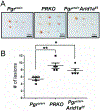ARID1A and PGR proteins interact in the endometrium and reveal a positive correlation in endometriosis
- PMID: 33706098
- PMCID: PMC8005488
- DOI: 10.1016/j.bbrc.2021.02.144
ARID1A and PGR proteins interact in the endometrium and reveal a positive correlation in endometriosis
Abstract
Endometriosis is a disorder in which endometrial cells normally limited to the lining of the uterus proliferate outside the uterine cavity and can cause pelvic pain and infertility. ARID1A levels are significantly reduced in the eutopic endometrium from women with endometriosis. Uterine specific Arid1a knock-out mice were infertile due to loss of epithelial progesterone receptor (PGR) signaling. However, the functional association of ARID1A and PGR in endometriosis has not been studied. We examined the expression patterns and co-localization of ARID1A and PGR in eutopic endometrium from women with and without endometriosis using immunostaining and Western blot analysis. ARID1A and PGR proteins co-localized in the epithelium during the proliferative and the early secretory phases. Our immunoprecipitation analysis and proximity ligation assay (PLA) revealed physical interaction between ARID1A and PGR-A but not PGR-B in the mouse and human endometrium. ARID1A levels positively correlated with PGR levels in the eutopic endometrium of women with endometriosis. Our results bring new perspectives on the molecular mechanisms involved in endometrial receptivity and progesterone resistance in endometriosis. The interrelationship between ARID1A and PGR may contribute to explaining the non-receptive endometrium in endometriosis-related infertility.
Keywords: ARID1A; Endometriosis; Endometrium; Progesterone receptor.
Copyright © 2021 Elsevier Inc. All rights reserved.
Conflict of interest statement
Declaration of competing interest The authors declare that they have no known competing financial interests or personal relationships that could have appeared to influence the work reported in this paper.
Figures




Similar articles
-
miR-196a overexpression activates the MEK/ERK signal and represses the progesterone receptor and decidualization in eutopic endometrium from women with endometriosis.Hum Reprod. 2016 Nov;31(11):2598-2608. doi: 10.1093/humrep/dew223. Epub 2016 Sep 12. Hum Reprod. 2016. PMID: 27619769
-
Progesterone Receptor B (PGR-B) Is Partially Methylated in Eutopic Endometrium From Infertile Women With Endometriosis.Reprod Sci. 2019 Dec;26(12):1568-1574. doi: 10.1177/1933719119828078. Epub 2019 Feb 19. Reprod Sci. 2019. PMID: 30782101
-
Krüppel-like factor 9 and progesterone receptor coregulation of decidualizing endometrial stromal cells: implications for the pathogenesis of endometriosis.J Clin Endocrinol Metab. 2012 Mar;97(3):E376-92. doi: 10.1210/jc.2011-2562. Epub 2012 Jan 18. J Clin Endocrinol Metab. 2012. PMID: 22259059 Free PMC article.
-
Progesterone and Estrogen Signaling in the Endometrium: What Goes Wrong in Endometriosis?Int J Mol Sci. 2019 Aug 5;20(15):3822. doi: 10.3390/ijms20153822. Int J Mol Sci. 2019. PMID: 31387263 Free PMC article. Review.
-
Progesterone Resistance in Endometriosis: an Acquired Property?Trends Endocrinol Metab. 2018 Aug;29(8):535-548. doi: 10.1016/j.tem.2018.05.006. Epub 2018 Jun 19. Trends Endocrinol Metab. 2018. PMID: 29934050 Review.
Cited by
-
Transcriptome Analysis of the Ovaries of Taihe Black-Bone Silky Fowls at Different Egg-Laying Stages.Genes (Basel). 2022 Nov 8;13(11):2066. doi: 10.3390/genes13112066. Genes (Basel). 2022. PMID: 36360303 Free PMC article.
-
The roles of chromatin regulatory factors in endometriosis.J Assist Reprod Genet. 2024 Apr;41(4):863-873. doi: 10.1007/s10815-024-03026-8. Epub 2024 Jan 25. J Assist Reprod Genet. 2024. PMID: 38270747 Free PMC article. Review.
-
A Mouse Model of Endometriosis with Nanoparticle Labeling for In Vivo Photoacoustic Imaging.Reprod Sci. 2022 Oct;29(10):2947-2959. doi: 10.1007/s43032-022-00980-5. Epub 2022 May 31. Reprod Sci. 2022. PMID: 35641854 Free PMC article.
-
Towards a Better Understanding of Endometriosis-Related Infertility: A Review on How Endometriosis Affects Endometrial Receptivity.Biomolecules. 2023 Feb 24;13(3):430. doi: 10.3390/biom13030430. Biomolecules. 2023. PMID: 36979365 Free PMC article. Review.
-
Mechanism of Action of NvZhen ErXian HeJi in Ovariectomized Rats with Myocardial Infarction based on Network Pharmacology.Curr Pharm Des. 2024;30(39):3116-3130. doi: 10.2174/0113816128308824240719093114. Curr Pharm Des. 2024. PMID: 39161145
References
-
- Marian S, Hermanowicz-Szamatowicz K, Endometriosis - a decade later - still an enigmatic disease. What is the new in the diagnosis and treatment?, Gynecological endocrinology : the official journal of the International Society of Gynecological Endocrinology (2019) 1–5. 10.1080/09513590.2019.1675045. - DOI - PubMed
Publication types
MeSH terms
Substances
Grants and funding
LinkOut - more resources
Full Text Sources
Other Literature Sources
Medical
Research Materials

